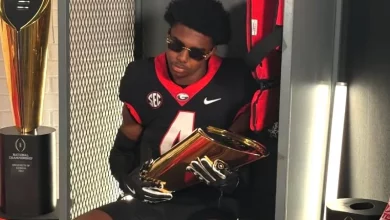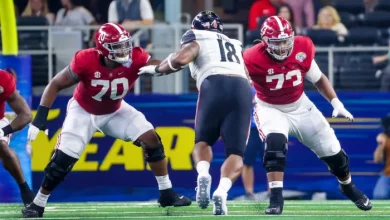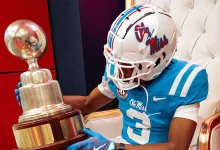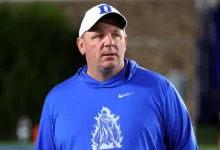Johnny Manziel believes that if the 2012 Texas A&M team had made the playoff, they could have made a significant impact and potentially competed for the national championship.

In the ever-evolving landscape of college football, the discussion over whether certain teams could have achieved greater success with different circumstances is both common and captivating. Among such debates, Johnny Manziel’s assertion that the 2012 Texas A&M Aggies could have made noise in the College Football Playoff (CFP) and challenged for the national title stands out as a compelling argument rooted in the team’s talent, performances, and the evolving dynamics of the sport during that era.
This comprehensive analysis explores Manziel’s perspective, the achievements and characteristics of the 2012 Texas A&M team, the context of college football in 2012 and the CFP era, and the broader implications of his comments. We will delve into the factors that support the idea that the Aggies could have been a formidable force in the playoff landscape, examining the team’s strengths, notable players, coaching philosophy, and the competitive environment of the time.
Setting the Stage: College Football in 2012 and the Rise of Johnny Manziel
The 2012 college football season was a pivotal year marked by intense competition, emerging star power, and a shifting playoff landscape. It was a season that ultimately culminated in the victory of Alabama over Notre Dame in the BCS National Championship Game, but it was also a year that laid the groundwork for the future of college football’s postseason format.
Johnny Manziel’s Breakout Year
Johnny Manziel, then a redshirt freshman at Texas A&M, burst onto the national stage with a spectacular inaugural season. His electrifying style of play, improvisational ability, and knack for making big plays earned him instant fame. He finished the year with 3,706 passing yards, 26 touchdowns, 1,410 rushing yards, and 21 rushing touchdowns — a feat unmatched by any quarterback in college football history at the time.
Manziel’s performances earned him the Heisman Trophy, making him the first freshman to win the award. His leadership and playmaking ability transformed Texas A&M into a formidable and exciting team, capable of competing with traditional powerhouses.
The SEC Powerhouse
In 2012, Texas A&M was part of the Southeastern Conference (SEC) — arguably the most competitive conference in college football. The Aggies finished the season 11-2, including a 6-2 record within the SEC, and secured a spot in the Cotton Bowl, where they defeated Oklahoma 41-13. Their only losses were to Florida and LSU, both top-tier programs.
The team’s offensive prowess was undeniable, and under head coach Kevin Sumlin, they played an aggressive, high-powered style that kept defenses on their heels. The offensive scheme maximized Manziel’s dual-threat capabilities, and the defense, while sometimes inconsistent, had moments of brilliance.
Cultural and Strategic Shifts
The 2012 season was also a reflection of college football’s broader evolution toward more dynamic offensive schemes, emphasizing quarterback mobility, spread concepts, and explosive plays. Manziel epitomized this shift, and his ability to extend plays and create chaos for defenses was a hallmark of that season.
Johnny Manziel’s Perspective: Why He Believes 2012 Could Have Made Noise in the Playoff
Johnny Manziel’s assertion that the 2012 Texas A&M team could have made a significant impact in the CFP and competed for the national championship is rooted in several key observations:
Talent and Playmaking Ability: The team boasted some of the most talented players in college football, especially on offense. Manziel himself was a generational talent, and the supporting cast included top-tier skill players, offensive linemen, and a defense capable of making key stops.
Offensive Innovation: The Aggies’ offense under Sumlin and with Manziel was one of the most exciting and effective in the country. Its ability to adapt and produce big plays against top defenses suggested it could have thrived in a playoff setting.
Team Confidence and Momentum: Texas A&M’s strong finish, including a dominant bowl win, demonstrated their resilience and ability to compete at a high level. Manziel’s leadership and the team’s overall swagger indicated they believed they could have risen to the occasion.
The Evolving Playoff Landscape: Although the College Football Playoff did not exist in 2012, Manziel’s comments are retrospective and speculative. He suggests that with the CFP’s format, which includes four teams and increased opportunities for high-scoring, exciting matchups, the Aggies could have been contenders.
The 2012 Texas A&M Team: Strengths and Key Players
To understand the potential of the 2012 Aggies, it’s essential to analyze their strengths, key players, and the team’s overall profile.
Offensive Prowess
Johnny Manziel: The heart and soul of the team, his dual-threat ability made him a nightmare for defenses. His improvisational skills, quick decision-making, and fearless playstyle set him apart.
Receiving Corps: Texas A&M’s receiving group was talented, featuring players like Ryan Swope, who was a reliable target and one of the top receivers that season. Swope’s route-running and hands complemented Manziel’s playmaking.
Offensive Line: The offensive line was solid, providing protection and creating running lanes for Manziel and the running backs.
Running Game: The team’s rushing attack, led by versatile backs, added another dimension to their offense, making them difficult to defend.
Defensive Strengths and Weaknesses
Defensive Line and Linebackers: The defense had playmakers capable of disrupting opponents, including pass rushers and run-stoppers. However, they occasionally struggled against high-powered offenses.
Secondary: The secondary had standout players but was sometimes vulnerable to big plays, a common trait in fast-paced, aggressive defenses.
Notable Players
Damontre Moore: An outstanding pass rusher who anchored the defensive line and created pressure on opposing quarterbacks.
Jonathan Stewart and Others: Contributing on the defensive side, these players added depth and versatility.
Special Teams and Overall Team Identity
The team played with confidence, swagger, and a belief that they belonged among college football’s elite. Their style of play was unorthodox and electrifying, making them a spectacle for fans and a headache for opponents.
The 2012 College Football Landscape and the CFP Context
In 2012, college football operated under the BCS system — a combination of polls and computer rankings that determined the two teams to play for the national championship. The BCS era was often criticized for its limited access and controversy over which teams earned spots.
The Top Teams of 2012
Alabama: Reigning national champions, led by Coach Nick Saban, with a dominant defense and efficient offense.
Notre Dame: An undefeated team that made it to the BCS title game, highlighting the unpredictability of the system.
Georgia and Florida: Other SEC teams with strong records and rankings.
The discussion about whether Texas A&M could have broken into the BCS title game was ongoing, but the team’s 11-2 record and competitive schedule suggested they might have had a case.
The Emergence of the CFP
Although the CFP did not come into existence until the 2014 season, Johnny Manziel’s comments are speculative, imagining a world where a playoff system existed in 2012. Under the CFP format, with four teams selected based on rankings, Texas A&M’s resume could have been evaluated differently, potentially giving them a shot at the postseason.
Why Might the 2012 Texas A&M Have Made Noise in the Playoff?
Offensive Explosiveness
The Aggies’ high-powered offense, led by Manziel, was capable of scoring quickly and often. In a playoff environment where explosive plays and high-scoring games are common, their style could have posed problems for traditional defenses.
Resilience and Confidence
The team’s resilience, demonstrated by comebacks and dominant bowl wins, suggested they could handle playoff pressure.
Matchup Potential
Against the top-ranked teams of that year, Texas A&M’s offense could have exploited weaknesses, especially with Manziel’s improvisational ability and the team’s fast-paced approach.
Underdog Status
In a playoff setting, being perceived as an underdog can motivate teams, and Texas A&M’s relative newcomer status to national prominence could have fueled their motivation to prove doubters wrong.
Broader Implications and Johnny Manziel’s Legacy
Johnny Manziel’s belief underscores the idea that talent, confidence, and the right circumstances can elevate a team’s chances of achieving greatness. His comments reflect a broader narrative in college football about the potential for teams to rise above expectations and challenge established powers.
The Evolution of College Football
The transition from BCS to CFP has increased opportunities for teams like Texas A&M to compete for national titles, aligning with Manziel’s optimism about the team’s potential.
The Role of Leadership and Culture
Manziel’s leadership and the team’s swagger exemplify how culture and mindset influence a team’s ability to succeed on big stages.
The Power of Retrospective Analysis
Reflecting on 2012 with the CFP in mind allows fans and analysts to reconsider the season’s landscape and appreciate the talent and potential that perhaps was overlooked in the era’s rankings.
The Significance of Johnny Manziel’s Perspective
Johnny Manziel’s assertion that the 2012 Texas A&M team could have made noise in the College Football Playoff and competed for the national championship is rooted in the team’s exceptional talent, dynamic style of play, and the evolving nature of college football. His belief underscores the idea that with the right circumstances, confidence, and a bit of luck, even a relatively new program can challenge the traditional powerhouses.
While history is fixed in the realm of actual results, the importance of such reflections lies in inspiring future teams, emphasizing that talent and determination can defy expectations, and that the sport’s narrative is always open to new possibilities. Manziel’s comments serve as a testament to the potential of that 2012 team and the enduring excitement of college football’s unpredictability.









